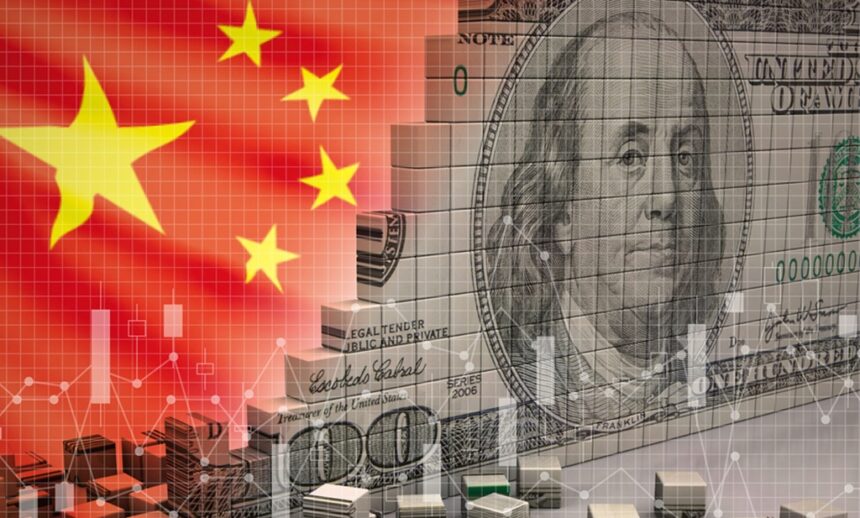BEIJING – China trimmed $8.2 billion from its U.S. Treasury holdings in April 2025, bringing its total to $757.2 billion. This shift in approach reflects growing pressure on China’s economy and has moved the country into third place among foreign holders of U.S. Treasuries, behind the UK, which holds $807.7 billion.
For the first time in 17 years, China has fallen from its spot as the second-largest holder. The drop fits a longer pattern, with China reducing its Treasury holdings by 44% since 2013. These changes come as the People’s Bank of China struggles with long-term price drops, a weak housing sector and the threat of stagnation.
China appears to be steering its foreign reserves away from U.S. dollar assets. Xi Junyang, a professor at Shanghai University, points out that this shift shows China’s decision to balance its reserves, with a bigger focus on gold and other currencies in the region.
Since 2022, China has added about 200 tonnes of gold, raising gold’s share in its reserves to 6.8% from 3.4% three years ago. U.S. Treasuries now make up just 22% of China’s reserves, their lowest level in at least 15 years. This move is partly a reaction to recent U.S. tariffs and a wider effort among BRICS countries to loosen ties to the U.S. dollar.
China Stagflation Looms
China’s economy is under strain. Private sector forecasts put 2025 growth at 4-5%, but weak demand and ongoing deflation are raising fears of stagnation. The central bank has tried to boost growth by cutting key rates by 10 basis points and lowering the reserve ratio by 50 basis points in May 2025. Still, these steps have yet to turn things around.
Consumer spending is stuck, with job worries and a long slump in property weighing people down. The property sector, once a major part of China’s economy, has been troubled since 2021. This has hurt investment and reduced household wealth, which is closely linked to home values.
Exports have also suffered due to higher U.S. tariffs, which climbed to 51.1% in 2025. As a result, Chinese companies have redirected goods meant for the U.S. to local customers, sparking fierce price cuts and deepening deflation. Analysts at Morgan Stanley expect producer price deflation to worsen to 2.8% in April 2025, up from 2.5% in March, showing the growing strain.
China’s Property Market Decline
China’s housing market, long a foundation of its growth, is in trouble. Goldman Sachs warns that real home prices may drop another 10% by 2027, after already losing 20% since late 2021. Their study of major housing downturns worldwide suggests China’s property bust could last another two years, with a typical total price drop of 30% over six years.
Unlike some countries, China’s leaders have been cautious about using large stimulus packages, wary of creating new risks.
In May 2025, new home prices in 70 cities fell 0.22% from the previous month, the biggest slide in seven months, data from the National Bureau of Statistics shows. Only three cities saw second-hand prices hold steady or rise.
Alongside the market slump, China’s shrinking population is expected to cut housing demand by 500,000 units each year through the decade, according to Goldman Sachs. Slower urban growth adds to the pressure, especially in city centres.
The government is now focusing more on city renewal and repairs, rather than new builds, which is likely to pull down demand further. Goldman Sachs predicts annual demand for new homes could fall below five million, well off the 2017 peak of 20 million.
Deflation and Policy Hurdles
Recent moves to boost the market, such as easing loan rules and lowering rates, have shown little effect. Premier Li Qiang’s call for stronger action to stop the slide signals the problem’s seriousness, but analysts like Louise Loo from Oxford Economics see little sign of a fast recovery.
China’s battle with falling prices is becoming harder. Producer prices in May 2025 reached their lowest in nearly two years, while consumer prices continued to drop, with the consumer price index down 0.2% month-on-month. Price wars in sectors like cars have hurt profits and shaken confidence.
Zhiwei Zhang of Pinpoint Asset Management sees the renewed decline in property prices as a worrying sign after a brief pause. The central bank has promised faster action, including moves to revive the housing market and deal with excess land holdings, but many experts think deeper support is needed.
Officials in Beijing have held off on big fiscal spending, arguing that mild deflation helps families save during a slow transition. This approach risks letting the spiral worsen, especially as higher U.S. tariffs and a weakening property sector squeeze demand. Ting Lu from Nomura warns that the double hit from exports and housing could cause an even bigger shock than expected.
Global Impact
China’s sale of U.S. Treasuries has caught the attention of global investors, with some warning it might push up U.S. mortgage rates if more countries follow. China’s holdings of U.S. mortgage-backed securities were down 8.7% year-on-year by September 2024, already adding to higher mortgage rates in the U.S. This has put more strain on housing in the U.S.
Still, the immediate effect of the latest $8.2 billion sale is limited due to the size of the Treasury market. The bigger concern is the clear shift in China’s financial priorities, which could change global money flows over time.
As China faces falling prices, a weak housing market and overseas pressure, its central bank has tough choices ahead. The move away from U.S. Treasuries signals a new strategy, but without stronger policy moves, China’s economy could stay stuck for longer.
For investors and markets worldwide, China’s troubles are likely to send ripples far beyond its borders.














